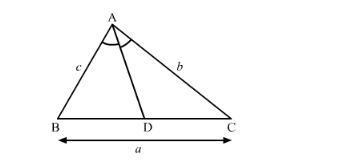In ∆ABC, ray AD bisects ∠A and intersects BC in D. If BC = a, AC = b and AC = c, prove that
(i) $\mathrm{BD}=\frac{a c}{b+c}$
(ii) $\mathrm{DC}=\frac{a b}{b+c}$
Given: In $\triangle A B C$ ray $A D$ bisects angle $A$ and intersects $B C$ in $D$, If $B C=a, A C=b$ and $A B=c$
To Prove:
(i) $B D=\frac{a c}{b+c}$
(ii) $D C=\frac{a b}{b+c}$
(i) The corresponding figure is as follows

Proof. In triangle $A B C, A D$ is the bisector of $\angle A$
Therefore $\frac{A B}{A C}=\frac{B D}{C D}$
Substitute $B C=a, A C=b$ and $A B=c$ we get,
$\frac{c}{b}=\frac{B D}{B C-B D}$
$\frac{c}{b}=\frac{B D}{a-B D}$
By cross multiplication we get.
$c(a-B D)=b \times B D$
$a c-c B D=b B D$
$a c=b B D+c B D$
$a c=(b+c) B D$
$\frac{a c}{b+c}=B D$
We proved that $B D=\frac{a c}{b+c}$
(ii) Since $B C=C D+B D$
$\Rightarrow C D=B C-B D$
$C D=a-\frac{a c}{b+c}$
$=\frac{a b}{b+c}$
